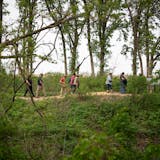McCown's longspur probably is a bird you've never heard of, even if it did make news in August.
That's when its name was changed.
It is now the thick-billed longspur because namesake John Porter McCown was at one time an officer in the Confederate army.
The longspur is a bird of wide horizons and short grass, a prairie bird. McCown was on duty with the U.S. Army in Texas when he shot the bird, at that time officially unknown to science.
He sent it to a friend, amateur ornithologist George N. Lawrence, who gave it McCown's name, and then offered the first scientific description of it.
It was common to name birds after the person who found or recognized a species not previously described in ornithological literature, i.e. a precise and complete description from which future identification could be made.
Formal proposals to rename the longspur date to 2018, and the name change was made this year after petitions requesting that action were once again presented to the American Ornithological Society. It has committees responsible for official bird names in North and South America.
The name of a person given to a bird is known as an honorific. It can honor collection of the first specimen, as in McCown's case.
![Three weeks ago, Octavio Rodriguez switched from making transmission parts to casting parts for hospital bed brake assemblies at Twin City Die Castings. ] GLEN STUBBE • glen.stubbe@startribune.com Thursday, April 9, 2020 How employee-owned Twin City Die Casting, which just laid off 40 production workers of its 250 employees in what was supposed to be a good year, is trying to accelerate its pivot to growing medical parts business for ventilators, hospital beds, etc as it copes with instan](https://arc.stimg.co/startribunemedia/WNZYKGTZ5IYMUCO3KI5TR3N7WI.jpg?&w=80&ar=1:1&fit=crop)

djoles@startribune.com As boaters flock to Minnesota lakes and rivers this holiday weekend for the unofficial kick-off to the boating season, they'll face more inspections in and out of the water as local cities and counties ramp up their work to stop the spread of invasive species. Across the metro, more boat accesses will be staffed by watercraft inspectors thanks to $10 million funneled to county government programs this year, up from $4.5 million the state allocated last year. ORG XMIT: MIN1505222156290209 ORG XMIT: MIN1506021218440580](https://arc.stimg.co/startribunemedia/34QSKO44B2XKVNUZCO5SLJQSLY.jpg?&w=80&ar=1:1&fit=crop)
